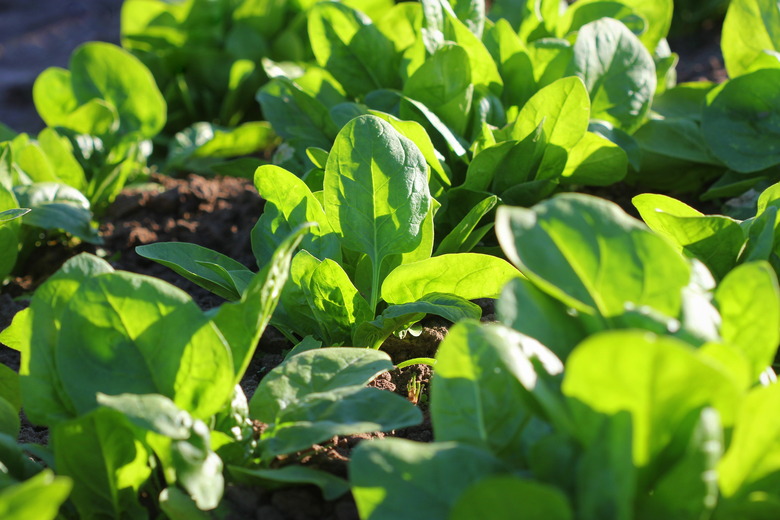Plant Pigments Found In Spinach
What are the plant pigments found in spinach leaves? There are several, and a simple laboratory experiment can provide an answer to this question. Using thin-layer chromatography, a non-chemical process that utilizes physical interactions between different molecules to sort them, the pigments in spinach leaves can be separated and then identified. Chromatography of an extract of spinach leaves will reveal several different plant pigments, including chlorophylls, carotenoids and anthocyanins.
Chlorophyll Pigments in Spinach Leaves
Chlorophyll Pigments in Spinach Leaves
Using spinach extract chromatography, the main plant pigments that will separate out are those that give the plant its dark green color. Chlorophylls, which are plant pigments essential for the process of photosynthesis, are green pigments that are found in large quantities in spinach leaves.
Two types of these pigments, both chlorophyll a and chlorophyll b, are present in spinach leaves. Chlorophylls are the photosynthetic pigments that are located in the chloroplasts of spinach leaves and other kinds of plants. Both types of chlorophyll reflect green light, which gives the pigments their green appearance.
Chlorophyll a is blue-green, while chlorophyll b is yellow-green. Chlorophyll a and b both absorb red and blue light, capturing this energy to fuel photosynthesis. Chlorophyll a is the primary pigment of photosynthesis, while chlorophyll b plays a supporting role in photosynthesis. Chlorophyll a is the most abundant type of this kind of pigment and is found in all photosynthetic plants.
Carotenoid Pigments in Spinach
Carotenoid Pigments in Spinach
The green color of spinach leaves that we see is actually a combination of several plant pigments, including chlorophylls and carotenoids. Carotenoids are also involved in photosynthesis, but they are not green – they are yellow, orange or red.
This type of pigment assists with photosynthesis by absorbing green light, the color of light that chlorophylls cannot take in, and transferring the energy from this light to the chlorophylls to use in photosynthesis. There are two types of carotenoids: carotenes and xanthophylls. Both types are found in spinach leaves.
Beta-carotene is a carotene found in spinach leaves that is yellow-orange. Spinach leaves also contain xanthophyll, a yellow carotenoid. Other fruits and vegetables with higher levels of carotenes and xanthophylls, like carrots, peppers, yams and oranges, are yellow, red or orange.
Carotenoids are important for human health, but animals cannot manufacture these pigments on their own – they must be consumed in food sources. Humans convert beta-carotene into vitamin A, which is important for healthy vision, immune response and reproduction. Strong antioxidants, carotenoids have also been found to help fight cancer. Over 600 types of carotenoids have been identified.
Other Spinach Pigments
Other Spinach Pigments
Along with chlorophylls and carotenoids, spinach leaves also contain plant pigments called anthocyanins. Anthocyanins are non-photosynthetic plant pigments that are red, purple or blue in color. Because of their vibrant hues, anthocyanins are often used to dye textiles.
Anthocyanins are water-soluble pigments that are present in many flowers, fruits, vegetables and berries. These plant pigments are responsible for the changing leaf color of deciduous trees in the autumn.
Anthocyanins are powerful antioxidants - chemical compounds that degrade quickly and that inhibit cell damage from oxidation in the body. Foods rich in anthocyanins have been linked to many human health benefits, including prevention of cancer and enhancement of heart health. Brightly colored foods like blueberries, blackberries, beets, red cabbage, cranberries, cherries and pomegranate contain high levels of anthocyanins.
Although anthocyanins do not play a direct role in photosynthesis, they help plants grow and reproduce in other ways. These pigments help create the diverse colors of flowering plants and fruits, attracting pollinators and animals that help in seed dispersal. In addition, anthocyanins absorb ultraviolet light, which protects plant leaves from damaging light rays.
Cite This Article
MLA
Sloane, Christina. "Plant Pigments Found In Spinach" sciencing.com, https://www.sciencing.com/plant-pigments-found-in-spinach-12550803/. 30 September 2021.
APA
Sloane, Christina. (2021, September 30). Plant Pigments Found In Spinach. sciencing.com. Retrieved from https://www.sciencing.com/plant-pigments-found-in-spinach-12550803/
Chicago
Sloane, Christina. Plant Pigments Found In Spinach last modified March 24, 2022. https://www.sciencing.com/plant-pigments-found-in-spinach-12550803/
